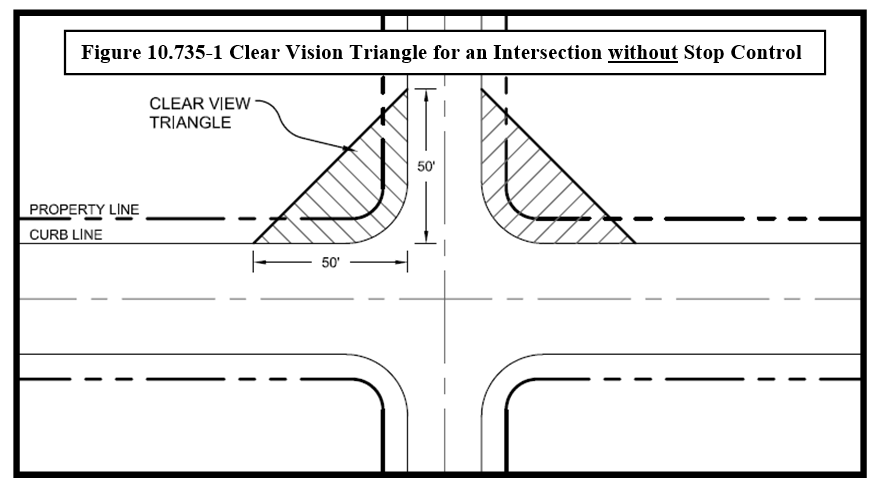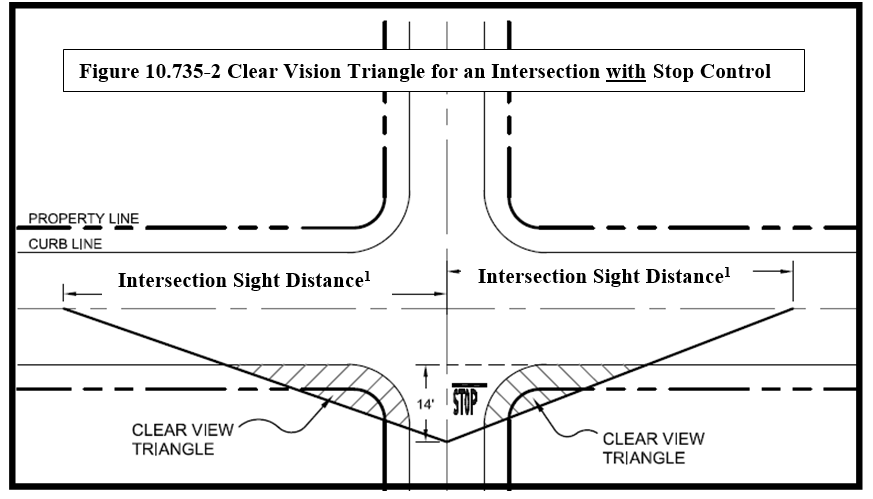10.735 Clear View of Intersecting Streets.
(1) In order to provide a clear view of intersecting streets, there shall be a triangular area of clear vision formed where a street intersects with another street, driveway, or alley.
(2) The size of the triangular area is a function of traffic control, volume and speed. See Table 10.735 -1 below for posted speeds and site distances.
(3) On any portion of a lot that lies within the triangular area described and illustrated in Figures 10.735.-1 & 2, below, nothing shall be erected, placed, planted, or allowed to grow in such a manner as to impede vision between a height of three (3) feet and ten (10) feet above the height of the top of the curb. Where there is no curb, the height shall be measured from the street center lines.
(4) The triangular area of clear vision shall be determined based upon the type of stop control used at the subject intersection.
(a) The clear vision triangular area for an intersection of a street without stop control is shown in Figure 10.735-1. See Table 10.735-2 below for determining all other curb line distances.
Figure 10.735-1. Clear Vision Triangle for an Intersection without Stop Control

(b) The clear vision triangle area for an intersection of a street, alley or driveway with stop control is shown in Figure 10.735-2.
(c) Stop controlled intersections include driveways, alleys, and intersections with signals or stop signs.
Figure 10.735-2. Clear Vision Triangle for an Intersection with Stop Control

1The clear vision triangle for intersections with stop control shall be determined using Table 10.735-1.
POSTED SPEED LIMIT | INTERSECTION SIGHT DISTANCE (ft.) |
|---|---|
20 | 115 |
25 | 155 |
30 | 200 |
35 | 250 |
40 | 305 |
45 | 360 |
50 | 425 |
55 | 495 |
(d) On one-way streets, the clear vision triangle may be reduced or deleted on the down-stream side of the intersection with approval of the Director of Public Works or designee.
(e) For alleys and streets with no curb in place, the anticipated location of the curb at full street build-out as per the current City of Medford Transportation System Plan (TSP) shall be used. Table 10.735-2 specifies the distance the curb would be expected from the right-of-way line.
Street Type | Right-of-Way Width (feet) | Distance Curb is to be Located from Edge of Right-of-Way (feet) |
|---|---|---|
Major Arterial | 100 ft. | 15 ft. |
Minor Arterial | 78 ft. | 15 ft. |
Major Collector | 74 ft. | 15 ft. |
Minor Collector | 72 ft. | 13.5 ft. |
Commercial | 63 ft. | 13.5 ft. |
Industrial | 80 ft. | 13.5 ft. |
Standard Residential | 63 ft. | 13.5 ft. |
Minor Residential | 55 ft. | 13.5 ft. |
Residential Lane | 30 ft. | 3 ft. |
Alley | Varies | 0 |
(5) The preceding provisions (1) through (4) of this Section shall not apply to the following:
(a) A public utility pole;
(b) A tree trimmed (to the trunk) to a line at least eight feet above the level of the intersection;
(c) Another plant species, other than trees of open growth habit, that is not planted in the form of a hedge, and which is so planted and trimmed as to leave, at all seasons, a clear and unobstructed cross-view;
(d) A supporting member or appurtenance to a permanent building lawfully existing on the date this standard became effective;
(e) An official warning sign or signal;
(f) A place where the natural contour of the ground is such that there can be no cross-visibility at the intersection.